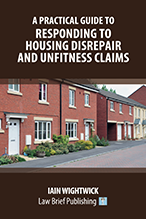A Practical Guide to Responding to Housing Disrepair and Unfitness Claims

Disrepair (or more properly “housing conditions”) claims are on the rise. This book should be helpful to those receiving and responding to them.

Disrepair (or more properly “housing conditions”) claims are on the rise. This book should be helpful to those receiving and responding to them.
by Iain Wightwick
£49.99
Published: July 2023
Such claims increased by 44% between 2012 and 2017 in England and Wales and they have continued to proliferate. In those five years Southwark LBC paid out about £10,000,000 in damages and costs. Sheffield City Council has disclosed that it has spent more than £1 million fighting disrepair claims within the last 2 ½ years. There has been a 322% increase in cases, which they blame on claims management companies using “aggressive marketing tactics” to attract tenants who are unhappy about the state of their homes during the pandemic. That has been greatly exacerbated by the inability on the part of all landlords to do repairs other than urgent works.
Housing conditions claims are not just wasteful in terms of officer time and finances. They can be very stressful for those involved, particularly where landlords face large numbers of claims and their staff are already busy planning and carrying out repairs, maintenance and improvements. I anticipate that all landlords would prefer to direct their resources to repairs rather than legal fees.
The book is more about the strategies needed to deal with disrepair litigation rather than the substantive law.
If you are a tenant’s representative, I hope that the book will help you to weed out good claims from the many which are at present gratuitously and unnecessarily issued.
Fortunately, the Court of Appeal has just handed down a very helpful decision on an application for permission to appeal. In Hockett v Bristol City Council (2021) unreported, Ref: B2/2021/1025, Lord Justice Bean agreed with the approach which I conceived a number of years ago, and which has been approved of by many judges in the County Court.
I hope that the application of that philosophy to disrepair claims will dramatically reduce the legal bills currently being paid by social landlords. Many of the complaints which tenants are making about housing conditions should never have involved lawyers. You’ll need to buy the book to find out more about it though!
The book also addresses how to respond to a disrepair claim in the event that ADR is not appropriate or fails to appease the tenant.
ABOUT THE AUTHOR
Iain Wightwick is a barrister and mediator working from Unity Street Chambers in Bristol. He is a specialist property lawyer, with particular interest in landlord and tenant issues. His practice includes all areas of residential disputes especially in social housing, with a focus on neighbour nuisance and related anti-social behaviour matters (‘neighbours from hell’), housing disrepair and homelessness.
This is his second book. He wrote “A Practical Guide to Antisocial Behaviour Injunctions” in 2019.
He has thirty years’ experience of acting for social landlords and tenants and a reputation for creative, cost-controlling approaches to litigation and to alternative dispute resolution.
He has been instructed to advise and appear in many disrepair claims, mostly for landlords but sometimes for tenants. He has a unique approach amongst his colleagues to the issue. This centres around his belief that social landlords should be able to devote their resources to providing quality accommodation rather than paying lawyers’ fees.
Shortly after the first Housing Disrepair Protocol was published, he concluded that tenants should be directed to alternative dispute resolution rather than instructing lawyers to pursue the steps set out in the Housing Conditions Protocol and going to court.
This approach has saved his clients very substantial sums in legal costs, which in turn has benefited the tenants of those landlords. He wants to share the method with all landlords, with the aim of reducing the number of these claims and helping others to do the same.
CONTENTS
Preface
Acknowledgements
Table of Cases
Table of Legislation
Introduction
PART I: Avoiding Claims for Disrepair
Chapter 1: Estate Management Policies
PART II: RESPONDING TO THE LETTER OF CLAIM
Chapter 2: The Letter of Claim
Chapter 3: The Letter of Claim as a Guide
PART III: THE PRE-ACTION PROTOCOL AND ALTERNATIVE DISPUTE RESOLUTION
Chapter 4: The Fundamental Importance of the Pre-Action Protocol
Chapter 5: When Is Notice Not Required?
Chapter 6: The Protocol Requires a Claimant to Give Details of Notice
Chapter 7: Counterclaims for Disrepair
Chapter 8: Alternative Dispute Resolution
Chapter 9: Making Sure Your Complaints Process Is Fit for Purpose
Chapter 10: The Mechanics of the Complaints Process
Chapter 11: The Identity of the Claimant
Chapter 12: The Defects Alleged – Does Liability Arise?
Chapter 13: The Defects Alleged
Chapter 14: Disclosure in the Pre-Action Protocol
PART IV: AFTER PROCEEDINGS ARE ISSUED
Chapter 15: Expert Evidence
Chapter 16: Applications for Summary Judgement / Strike Out / Stay
Chapter 17: Drafting the Defence
Chapter 18: Transfer and Allocation to Track
Chapter 19: Disclosure and Inspection
Chapter 20: Witness Statements
PART V: PREPARING FOR TRIAL
Chapter 21: The Trial
Epilogue/Conclusion
Appendix 1: Example Stage 3 Complaints Finding
Appendix 2: Example Defence
Bibliography
Index


